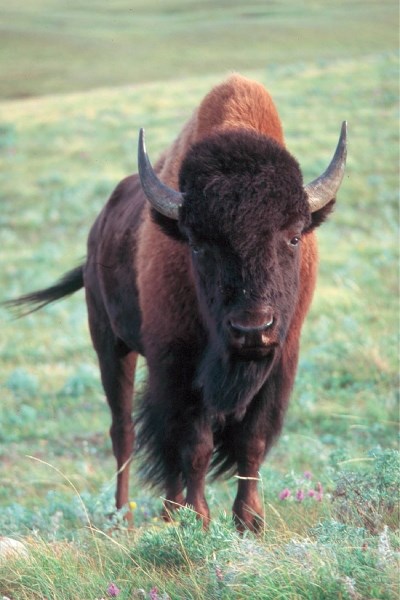Wolves in Banff National Park would not likely find an easy meal on the hoof if Parks Canada does indeed reintroduce plains bison.
According to Banff National Park wildlife biologist Tom Hurd, during his presentation Ecological Considerations for Plains Bison (Bison bison) restoration in Banff National Park – part of the Sixth Annual Canadian Society for Ecology and Evolution held at The Banff Centre May 12-15 – U.S. research, primarily in Yellowstone National Park, has shown that wolves in Banff may not have much effect on bison.
“(The research) seems to indicate that bison are hunted and killed by wolves, but are rarely limited by wolves,” Hurd said. “That is not always the case. Wood bison in the Mackenzie Bison Sanctuary or Wood Buffalo National Park sometimes appear to be limited by wolves and bison predation is much more significant.
“Those are simpler ecosystems with fewer prey species. In complex systems like Banff National Park and Yellowstone, bison are likely not the preferred species because of their defensive abilities. They are substantially harder to take down for wolf packs than most of the other prey available.
“Bison are low on the list of food items in a complex system. They likely wouldn’t change the predator-prey landscape extensively.”
Parks Canada is exploring the possibility of reintroducing bison to the Rocky Mountains, as part of the 2010 Banff National Park Management Plan. Before the federal agency makes that move, however, it has promised to address a variety of concerns, including the effect bison would have on wolves, and how that in turn could affect other more vulnerable species, such as caribou.
As part of its plan to work with the public and stakeholders, Hurd said consultation would likely begin this year.
“With what comes up and the issues addressed, the concept would likely roll out from there,” he said.
And while wolves may not see much benefit from having bison in Banff National Park if the plan is successful, the fact that wolves are at work in the valleys of the Rocky Mountains may benefit bison.
Wolves would help maintain the condition of woody forage and grasslands available to bison by keeping other ungulates, specifically elk, in check.
“Woody browse species (in Banff) are in much better condition because of wolf predation,” Hurd said.
As part of his presentation, Hurd also pointed out that bison would contribute to the goal of restoring ecological integrity in Banff National Park while at the same time meet the majority of the International Union for Conservation of Nature (IUCN) restoration criteria, established as a checklist to guide land managers considering a restoration project.
Other IUCN criteria that fit with the proposed Banff project include increasing the number of conservation herds in North America, ensuring the right bison are being considered for the region, the presence of wolves and absence of diseases and cattle genes in the reintroduction stock.
Another IUCN criteria that may be harder to address is the question of having a large cohort or group of mature bulls. From a conservation perspective, they would be beneficial, but for Parks it comes with containment issues as bulls tend to wander.
“Would keeping a large cohort of the most likely to disperse individuals be a wise idea? That also involves some serious thought and discussion,” Hurd said,
Other constraints which could influence bison restoration are property and safety issues both in and outside the park.
Experience in both Yellowstone and Prince Albert National Park shows that bison are adaptable and can use a variety of habitats.
“They’ll go almost anywhere there is forage,” Hurd said. “The issue is how adaptable do we want to be? From the perspective of a land manager and community, would you think bison are acceptable, less acceptable or not acceptable?”
Zoning is a way of managing the herd to keep the animals from townsites, along highways or tracks and off rural or agricultural land.
Archaeological and historical evidence has shown that plains bison were found in this region and plains bison at Elk Island National Park are free of diseases and cattle genes, and as a result, are used as seed stock for new herds.
“Banff was at the western edge of bison range defined by human predation. Bison were the dominant ungulate species, but their overall density was low,” Hurd said.
Evidence from six excavated sites in Banff National Park has demonstrated that bison were the dominant ungulate, but they had a low density overall, forcing early aboriginal people to work hard to find and kill the bison and utilize all of the nutrition from each bison; right down to pulverizing bones to get at the bone grease.
“All of the sites discovered so far have indications of bones being pulverized for the bone grease and that suggests you really worked hard to extract the last bit of nutrition from animals that you killed and it suggests that there weren’t many animals out there in the first place,” Hurd said.
Moving forward in the historical record, explorers on 26 expeditions between the mid-18th and mid-19th centuries, amounting to a total of 390 days in the Rockies, recorded more moose and elk and fewer bison.
But did these bison migrate into the Rockies from the plains and foothills, or were they residents?
Carbon isotope dating undertaken by Gwyn Langemann in 2000 shows 26 of 27 samples from Waterton Lakes and Banff had evidence of C-4 grasses in the bone structure, indicating bison killed in the Rockies would have spent some time in the grasslands east of the Rockies.
That, however, does not tell researchers if those animals migrated annually, or if they left the plains and became residents of the mountain valleys, but the concept of partial migration is feasible, Hurd said, as is year-round residency.




